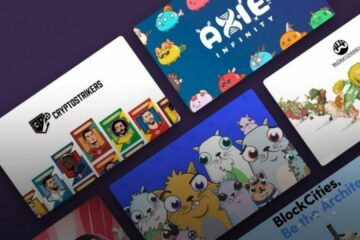On a conference call this week, EA CEO Andrew Wilson described NFTs and blockchain games as “an important part of the future of our industry”. which reflects what Ubisoft CFO Frédérick Duguet said earlier this week. Duguet believes the technology will “enable more play-to-earn, which allows more players to earn content and their own content, and we believe it will grow the industry quite a bit”.
However, EA’s Wilson added a cautionary note, “It’s early days to see how this will work”.
An NFT, in case you’re wondering, is a unique version of a digital asset. For example, a digital work of art (which you could normally share endlessly) can be “tokenized” to make it unique. The token acts as a kind of certificate that cannot be copied, so that it makes sense to sell your NFT asset completely with this authenticity at a later point in time.
Ubisoft and EA will no doubt join in with more publishers trying to take advantage of this approach where players earn cryptocurrency by playing a game. Sega has already announced that it will start selling NFTs based on its IPs.
NFT game is different and depends on the theme of the game. Designing the ultimate theme of the NFT game and programming the game logic are critical and should be the first step in designing a game from scratch. In addition, it is crucial to create a token economic model that uses NFTs to complement the gameplay. For example, we developed the LOCGame as an NFT-powered type of Top Trump Card Game on blockchain, where players can collect and win valuable tokens and NFT items. The Genesis Edition pays homage to the beloved crypto industry to the people and characters who made this crypto revolution possible. There are many DeFi perks in game design that offer players unique opportunities to become part of the game economy. Players can use NFT cards and be rewarded in tokens, with 10% of all prize pools being played with these used cards. Game economy models like this can be implemented as NFT token mechanisms that define the underlying token economy.
NFT games are becoming complex and therefore it is important to teach players how to use NFT in the game so that their intended in-game use case is used with a constant demand for the game.
Ishan Pandey: NFT Games aims to provide educational and learning opportunities for its players and collectors. How is an in-game incentive model structured in an NFT-based game economy?
Mikhail Mironov: Top Trumps are both fun and educational card games. When the player is playing and having fun, the player will get a lot of information about the crypto industry, such as professions and characters that make up this industry, and it will expand to cities as another category so that the player will learn a lot of facts about the urban geography. Additionally, the game has the earn-to-play element that rewards players, tournaments, and multiple partnerships with other crypto startups in the pipeline to bring exciting rewards to the community.
It is important to build a vibrant community around the NFT game to ensure that the NFT economy in the game continues to grow year after year. The community creates added value for NFT in the game and it is recommended that the community be allowed to contribute ideas to the team in order to further expand the ecosystem.
NFTs enter the world of video games
Non-fungible tokens (NFTs) have been in the spotlight for the past few months. Until now, they have mostly been used in the sale of digital works, memes or social media posts, but it is also the world of video games which is slowly but surely being transformed by technology.
NFTs allow you to associate a unique code with any digital object and thus sell the original copy of it. The founder of Twitter, Jack Dorsey, for example, sold his very first “tweet” transformed into NFT for the sum of 2.9 million US dollars last March.
NFTs are a new way of trading digital assets that is based on the blockchain, the technology behind cryptocurrencies like bitcoin (BTC) and ethereum tokens (ETH or ether).
In video games, NFTs can be used to manage the exchange of unique elements between players and players, and this is what is being pushed forward with new games that attempt to revolutionize the industry.
Get paid to play?
Axie Infinity is the most popular game when it comes to using NFTs. Last July, the Vietnamese company Sky Mavis, which developed it, claimed to have around 350,000 active accounts daily.
Inspired by Pokémon, this is a simple 2D game with a childish art style. The goal is to collect Axies, friendly creatures with various skills that are used to fight opponents.
What sets Axie Infinity apart from other games that share this premise is its upfront cost and the possibility of making a profit. To be able to play the game, you must first purchase a minimum of three Axies which are sold as NFTs in exchange for ether, the most widely used cryptocurrency after bitcoin.
As the value of these virtual creatures depends on the demand and the price of ether, it has been steadily increasing since the game’s debut in 2018. While you initially had to shell out $ 10 to $ 30 to start playing, it you have to pay nearly $ 1000 today to get started. It is also possible to borrow Axies in exchange for sharing your profits.
As they progress through the game and complete quests, players obtain special items, including Smooth Love Potions (SLP) which take the form of cryptocurrency. SLPs can then be sold on different platforms for real money.
To make a profit, it is also possible to breed Axies and sell them to new waves of players in the form of NFTs. This model, while it may seem profitable, is reminiscent of a pyramid scheme: you always have to find new people who are willing to buy Axies despite their ever rising prices.
According to the web publication The Conversation, the most experienced players can earn up to about $ 500 a day from selling SLPs and breeding Axies. Of course, the return is much lower for the average person, and only those users who are already well established in this virtual universe can expect such profits.
Axie Infinity represents NFT’s collection with the greatest value as a whole. Since its inception, more than $ 1 billion has been generated from the various transactions made on the game’s platform.
The most expensive item sold in the game is an Axie which cost 300 ETH, or just over one million Canadian dollars when the price is adjusted with the current value of this cryptocurrency.
NFTs?
Of course, Axie Infinity isn’t the only game trying to carve out a place for itself in the world of non-fungible tokens. Among other things, the system is particularly suitable for collectible card games, as it allows players to sell and buy unique items in a secure manner.
Older games have also decided to implement the technology at the heart of their market. This is the case for The Sandbox, a small game released in 2010 that is akin to titles like Minecraft and Roblox.
It is also known that the American company GameStop is currently working on creating its own platform for NFTs, but the purpose of this is still a mystery. For a video game retailer, this could for example be a way of allowing its customers to exchange virtual copies of certain titles, which is not currently possible with sales platforms. like Steam or the Epic Games Store.



0 Comments